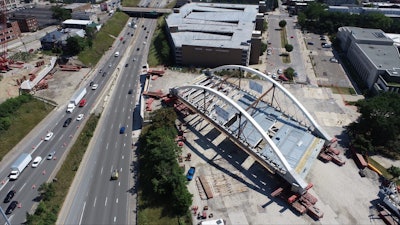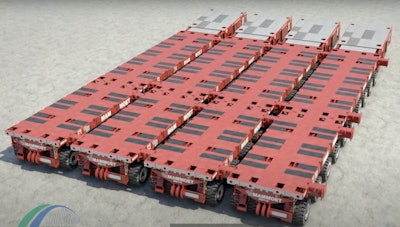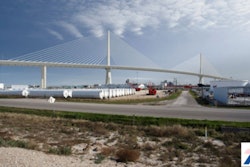
A new 5-million-pound bridge that will be the first of its kind in Michigan has been moved into place over the I-94 freeway in Detroit, thanks to special machinery known as self-propelled modular transporters.
The Michigan Department of Transportation closed the freeway July 22 for seven days to move what will become the new Second Avenue Bridge over I-94. The bridge skeleton was built over two years in a parking lot at nearby Wayne State University. (To watch a time-lapse video if its move, see the end of this story.)
 Four Mammoet self-propelled modular transporters were used to move the 5-million-pound Second Avenue skeleton bridge into place over I-94 in Detroit.Michigan DOT
Four Mammoet self-propelled modular transporters were used to move the 5-million-pound Second Avenue skeleton bridge into place over I-94 in Detroit.Michigan DOT
After the bridge was moved from the parking lot to the abutments for its new home over I-94, another SPMT was used to lift the leading end of the span and move it across the freeway to the opposite abutments. Then the bridge was jacked down into place.
After it is inspected, reinforced steel and concrete decking will be installed.
 The Second Avenue Bridge rolling into place.Michigan DOT
The Second Avenue Bridge rolling into place.Michigan DOT
Other uncommon design features:
- Tied arch – the ends of the arches are tied so they cannot spread laterally under the weight of the deck and traffic.
- Skewed – the bridge is not a rectangle but has two obtuse and two acute angles at its ends.
- Unbraced – there are no connections between the top of the arches.
The bridge is expected to last 50 to 60 years. The cables are replaceable.
The new Second Avenue Bridge is part of a more than $3 billion project to rebuild 6.7 miles of the I-94 freeway in Detroit. The bridge will consist of one lane in each direction, as well as have 9-foot-wide sidewalks and 8-foot-wide bike lanes. The replacement bridge is expected to open in the fall after final adjustments to the cables occur. MDOT says no cable adjustments will be made over live traffic.
The bridge was designed by TetraTech, and the tied-arch span by HDR. Z Contractors is the contractor for the $26 million bridge project.
Check out a time-lapse video below of the bridge move as tweeted by Michigan Lt. Gov. Garlin Gilchrist II:















